Applying Values-Led Communication Design to Engage Stakeholders in Developing Dementia-Friendly Visitor Destinations
Abstract
1. Introduction: Dementia-Friendly Visitor Destination Development as an Emerging Issue in Social Innovation
2. Literature Review
2.1. Stakeholders’ Communication as a Critical Challenge in DFVD Development
2.2. Values-Led Approach to Enhance Stakeholders’ Communication in DFVD Development
3. Action Research Project: Applying Values-Led Communication Design in DFVD Development
3.1. Context and Problem Setting
3.2. Structure of the DFVD Development Project
- Design for value proposition: the goal in this stage is to enable stakeholders to know each other and build up the share value proposition for DFVD development such that they feel meaningful to engage with and actionable. To achieve this goal, the steps of negotiation for values are organized to allow stakeholders to exchange knowledge and uncover the values of DFVD development from different perspectives, identify collaboration opportunities to render the values, and develop action plans to enact for DFVD development. To support this goal, the tools and activities applied in the three steps of negotiation for values include Service Safari, Service Staging, and Desktop Walkthrough.
- Design for value-in-context: the goal in this stage is that stakeholders engage with their roles within the interaction of values creation, so they can decide whether to commit resources to sustain DFVD development. Accordingly, the steps of negotiation for values are planned to engage all the stakeholders to the contexts to examine value creation, reconfigure the contexts, and establish strategies to adopt and sustain DFVD. The tools and activities used to support this goal within the three steps of negotiation for values include Storytelling, Contextual Interview, and Service Blueprint.
- Design for value constellation: the goal in this stage is to expand the network and integrate resources for DFVD development. Based on this idea, the steps of negotiation for values are orchestrated to allow the stakeholders to link potential values and disconnection, which are then connected to form the network and stabilize the relationship within the network. The tools and activities employed to the three steps of negotiation for values in this stage include Design Initiatives, Service Ecology Map, and Service Ecology Prototype.
3.3. Stage I: Design for Value Proposition
- ‘Maybe I can conduct animal-assisted therapy at Leofoo Park to provide a special fun day for PwD and carers (A6)’—the animal-assisted therapist has not fully uncovered the potential resources of Leofoo Park that can could benefit PwD, so she could only propose ideas from her first impression—using the environment in Leofoo Park to organize a one-day activity.
- ‘These suggestions are more like rules, which should be established by the government and apply to all the visitor destinations. I hope our efforts can focus on using our strength to create unique experiences for PwD and open up new market (A2)’—the Leofoo managers considered the collaboration should create values for all the stakeholders and allowing them to identify their strategic roles.
3.3.1. Applying Service Safari to Explore Participants’ Core Competences
3.3.2. Conducting Service Staging to Render the Emerging Values
3.3.3. Using Desktop Walkthrough to Identify Unique Experience and Action Plan
3.4. Stage II: Design for Value-In-Context
3.4.1. Using Storytelling to Allow PwD and Carers to Explore Values
3.4.2. Conducting Contextual Interviews to Examine Value Creation
3.4.3. Establishing Service Blueprint to Evaluate the Values of Implementing DFVD
3.5. Stage III: Design for Value Constellation
3.5.1. Applying Design Initiatives as Seeds to Uncover Values
3.5.2. Applying an Expectation Map to Render the Connection
3.5.3. Conducting Service Prototype to Promote Network
4. Discussion
4.1. Facilitating Participants to Stand in Others’ Shoes to Create Meaningful Communication
4.2. Values-Led Communication Design as a Process to Increase Societies’ Capabilities to Act
5. Conclusions and Future Research
Author Contributions
Funding
Institutional Review Board Statement
Informed Consent Statement
Data Availability Statement
Acknowledgments
Conflicts of Interest
References
- World Alzheimer Report 2015—The Global Impact of Dementia: An Analysis of Prevalence, Incidence, Cost and Trends. Available online: https://www.alzint.org/u/WorldAlzheimerReport2015.pdf (accessed on 11 March 2019).
- World Alzheimer Report 2018—The State of the Art of Dementia Research: New Frontiers. Available online: https://www.alzint.org/u/WorldAlzheimerReport2018.pdf (accessed on 13 March 2019).
- Dementia: A Public Health Priority. Available online: https://www.who.int/mental_health/publications/dementia_report_2012/en/ (accessed on 20 March 2019).
- Chen, P.J.; Yang, S.Y.; Wang, C.S.; Muslikhin, M.; Wang, M.S. Development of a Chinese Chess Robotic System for the Elderly Using Convolutional Neural Networks. Sustainability 2020, 12, 3980. [Google Scholar] [CrossRef]
- Klimova, B.; Kuca, K. Speech and language impairments in dementia—A mini review. J. Appl. Biomed. 2016, 14, 97–103. [Google Scholar] [CrossRef]
- Innes, A.; Page, S.J.; Cutler, C. Barriers to leisure participation for people with dementia and their carers: An exploratory analysis of carer and people with dementia’s experiences. Dementia 2015, 15, 1–23. [Google Scholar] [CrossRef] [PubMed]
- Dementia 2013: The Hidden Voice of Loneliness. Available online: https://www.basw.co.uk/resources/dementia-2013-hidden-voice-loneliness (accessed on 2 January 2019).
- Connell, J.; Page, S.J. Case study: Destination readiness for dementia-friendly visitor experiences: A scoping study. Tour. Manag. 2019, 70, 29–41. [Google Scholar] [CrossRef]
- Klimova, B. Tourists with Dementia–A Unique Challenge for the Tourism Industry. Pertanika J. Soc. Sci. Humanit. 2018, 583–588. [Google Scholar]
- Teri, L.; Logsdon, R.G.; McCurry, S.M. Exercise interventions for dementia and cognitive impairment: The Seattle Protocols. J. Nutr. Health Aging 2008, 12, 391–394. [Google Scholar] [CrossRef] [PubMed]
- Page, S.J.; Innes, A.; Cutler, C. Developing dementia-friendly tourism destinations: An exploratory analysis. J. Travel Res. 2015, 54, 467–481. [Google Scholar] [CrossRef]
- Connell, J.; Page, S.J.; Sheriff, I.; Hibbert, J. Business engagement in a civil society: Transitioning towards a dementia-friendly visitor economy. Tour. Manag. 2017, 61, 110–128. [Google Scholar] [CrossRef]
- Fiore, M.; Galati, A.; Golebiewski, J.; Drejerska, N. Stakeholders’ involvement in establishing sustainable business models: The case of Polish dairy cooperatives. Br. Food J. 2020, 122, 1671–1691. [Google Scholar] [CrossRef]
- Rethinking Heritage: A Guide to Help Make Your Site More Dementia-Friendly. Historic Royal Palaces. Available online: https://www.hrp.org.uk/media/1544/2017-11-14_rethinkingheritage_lowres_final.pdf (accessed on 10 July 2018).
- Friedman, B.; Kahn, P.H., Jr.; Borning, A. Value sensitive design and information systems. In The Handbook of Information and Computer Ethics; Himma, K.E., Tavani, H.T., Eds.; John Wiley & Sons: Hoboken, NJ, USA, 2008; pp. 69–101. [Google Scholar]
- Woelfer, J.P.; Iverson, A.; Hendry, D.G.; Friedman, B.; Gill, B. Improving the safety of homeless young people with mobile phones: Values, form and function. In Proceedings of the SIGCHI Conference on Human Factors in Computing Systems; ACM Press: New York, NY, USA, 2011; pp. 1707–1716. [Google Scholar]
- Connell, J.; Page, S.J. An exploratory study of creating dementia-friendly businesses in the visitor economy: Evidence from the UK. Heliyon 2019, 5, 1–30. [Google Scholar] [CrossRef]
- Butt, A.; Naaranoja, M.; Savolainen, J. Project change stakeholder communication. Int. J. Proj. Manag. 2016, 34, 1579–1595. [Google Scholar] [CrossRef]
- Saji, B.S.; Ellingstad, P. Social innovation model for business performance and innovation. Int. J. Product. Perform. Manag. 2016, 65, 256–274. [Google Scholar] [CrossRef]
- Schwartz, S.H. Are there universal aspects in the structure and contents of human values? J. Soc. Issues 1994, 50, 19–45. [Google Scholar] [CrossRef]
- Howell, R.A. It’s not (just) “the environment, stupid!” Values, motivations, and routes to engagement of people adopting lower-carbon lifestyles. Glob. Environ. Chang. 2013, 23, 281–290. [Google Scholar] [CrossRef]
- A Social Vision for Value Co-Creation in Design. Available online: https://timreview.ca/article/310 (accessed on 10 May 2015).
- Pera, R.; Occhiocupo, N.; Clarke, J. Motives and resources for value co-creation in a multi-stakeholder ecosystem: A managerial perspective. J. Bus. Res. 2016, 69, 4033–4041. [Google Scholar] [CrossRef]
- Babu, M.M.; Dey, B.L.; Rahman, M.; Roy, S.K.; Alwi, S.F.S.; Kamal, M.M. Value co-creation through social innovation: A study of sustainable strategic alliance in telecommunication and financial services sectors in Bangladesh. Ind. Mark. Manag. 2020, 89, 13–27. [Google Scholar] [CrossRef]
- Van der Velden, M.; Mörtberg, C. Participatory Design and Design for Values. In Handbook of Ethics, Values, and Technological Design; Van Den Hoven, M.J., Vermaas, P.E., van de Poel, I., Eds.; Springer: Heidelberg, Germany, 2015; pp. 41–66. [Google Scholar]
- Halloran, J.; Hornecker, E.; Stringer, M.; Harris, E.; Fitzpatrick, G. The value of values: Resourcing co-design of ubiquitous computing. CoDesign 2009, 5, 245–273. [Google Scholar] [CrossRef]
- Iversen, O.S.; Halskov, K.; Leong, T.W. Values-led participatory design. Codesign 2012, 8, 87–103. [Google Scholar] [CrossRef]
- Payne, A.F.; Storbacka, K.; Frow, P. Managing the co-creation of value. J. Acad. Mark. Sci. 2008, 36, 83–96. [Google Scholar] [CrossRef]
- FreeDay of Respite Travel. Available online: http://www.leofooresort.com.tw/zh-TW/?Nsn=315&Ssn=4403 (accessed on 9 September 2020).
- Chin, T.; Yang, Y.; Zhang, P.; Yu, X.; Cao, L. Co-creation of social innovation: Corporate universities as innovative strategies for Chinese firms to engage with society. Sustainability 2019, 11, 1438. [Google Scholar] [CrossRef]
- Porter, M.E.; Kramer, M.R. Creating shared value. Harv. Bus. Rev. 2011, 89, 1–17. [Google Scholar]
- Davis, J.; Nathan, L.P. Value sensitive design: Applications, adaptions, and critiques. In Handbook of Ethics, Values, and Technological Design; Van Den Hoven, M.J., Vermaas, P.E., van de Poel, I., Eds.; Springer: Heidelberg, Germany, 2015; pp. 11–40. [Google Scholar]
- Frauenberger, C.; Good, J.; Fitzpatrick, G.; Iversen, O.S. In pursuit of rigour and accountability in participatory design. Int. J. Hum. Comput. Stud. 2015, 74, 93–106. [Google Scholar] [CrossRef] [PubMed]
- Smith, R.C.; Bossen, C.; Kanstrup, A.M. Participatory design in an era of participation. CoDesign 2017, 13, 65–69. [Google Scholar] [CrossRef]
- Yoo, D. Stakeholder tokens: A constructive method for value sensitive design stakeholder analysis. Ethics Inf. Technol. 2018, 4, 1–5. [Google Scholar] [CrossRef]
- Ballantyne, D.; Frow, P.; Varey, R.J.; Payne, A. Value propositions as communication practice: Taking a wider view. Ind. Mark. Manag. 2011, 40, 202–210. [Google Scholar] [CrossRef]
- Frow, P.; Payne, A. A stakeholder perspective of the value proposition concept. Eur. J. Mark. 2011, 45, 223–240. [Google Scholar] [CrossRef]
- Greer, C.R.; Lusch, R.F.; Vargo, S.L. A service perspective: Key managerial insights from service-dominant (SD) logic. Organ. Dyn. 2016, 45, 28–38. [Google Scholar] [CrossRef]
- Chandler, J.D.; Vargo, S.L. Contextualization and value-in-context: How context frames exchange. Mark. Theory. 2011, 11, 35–49. [Google Scholar] [CrossRef]
- Makkonen, H.; Komulainen, H. Networked new service development process: A participant value perspective. Manag. Decis. 2014, 52, 18–32. [Google Scholar] [CrossRef]
- Löbler, H.; Hahn, M. Measuring value-in-context from a service-dominant logic’s perspective. Rev. Mark. Res. 2013, 10, 255–282. [Google Scholar]
- Polaine, A.; Løvlie, L.; Reason, B. Service Design: From Insight to Implementation; Louis Rosenfeld: New York, NY, USA, 2013. [Google Scholar]
- Corsaro, D.; Ramos, C.; Henneberg, S.C.; Naudé, P. The impact of network configurations on value constellations in business markets—The case of an innovation network. Ind. Mark. Manag. 2012, 41, 54–67. [Google Scholar] [CrossRef]
- Elliott, J. Action Research for Educational Change; Open University Press: Philadelphia, PA, USA, 1991. [Google Scholar]
- Selloni, D.; Corubolo, M. Design for social enterprises: How design thinking can support social innovation within social enterprises. Des. J. 2017, 20, 775–794. [Google Scholar] [CrossRef]
- Ministry of Healthand Welfare: Dementia Prevention Caring Policy and Action Plan 2.0 2018–2025. Available online: https://www.mohw.gov.tw/cp-139-541-2.html (accessed on 10 December 2018).
- Taiwan Alzheimer Disease Association Advocating Government to Promote Dementia-Friendly Tourism. Available online: http://tada2002.ehosting.com.tw/tada_event_detail.aspx?pk=1719 (accessed on 8 May 2018).
- Stickdorn, M.; Schneider, J. This is Service Design Thinking; John Wiley & Sons, Inc.: Hoboken, NJ, USA, 2011. [Google Scholar]
- Sanders, E.B.N.; Brandt, E.; Binder, T. A framework for organizing the tools and techniques of participatory design. In Proceedings of the 11th Biennial Participatory Design Conference, Sydney, Australia, 29 November–3 December 2010; pp. 195–198. [Google Scholar]
- Manzini, E. Making things happen: Social innovation and design. Des. Issues 2014, 30, 57–66. [Google Scholar] [CrossRef]
- Ceschin, F. How the design of socio-technical experiments can enable radical changes for sustainability. Int. J. Des. 2014, 8, 1–21. [Google Scholar]
- 2020 Award of Taiwan Healthy and Aging Friendly City. Available online: https://www.hpa.gov.tw/Pages/Detail.aspx?nodeid=4141&pid=13409 (accessed on 8 December 2020).
- Hochgerner, J. New Combinations of Social Practices in the Knowledge Society. In Challenge Social Innovation: Potentials for Business, Social Entrepreneurship, Welfare and Civil Society; Franz, H.W., Hochgerner, J., Howaldt, J., Eds.; Springer-Verlag: Berlin/Heidelberg, Germany, 2012; pp. 87–104. [Google Scholar]
- Murray, R.; Caulier-Grice, J.; Mulgan, G. The Open Book of Social Innovation; Young Foundation: London, UK, 2010. [Google Scholar]
- Rodgers, P.A.; Mazzarella, F.; Conerney, L. Interrogating the Value of Design Research for Change. Des. J. 2020, 23, 491–514. [Google Scholar] [CrossRef]
- Cajaiba-Santana, G. Social innovation: Moving the field forward. A conceptual framework. Technol. Forecast. Soc. Chang. 2014, 82, 42–51. [Google Scholar] [CrossRef]
- Wisdom, J.P.; Chor, K.H.B.; Hoagwood, K.E.; Horwitz, S.M. Innovation adoption: A review of theories and constructs. Adm. Policy Ment. Health 2014, 41, 480–502. [Google Scholar] [CrossRef] [PubMed]
- Björgvinsson, E.; Ehn, P.; Hillgren, P.A. Agonistic participatory design: Working with marginalised social movements. Codesign 2012, 8, 127–144. [Google Scholar] [CrossRef]

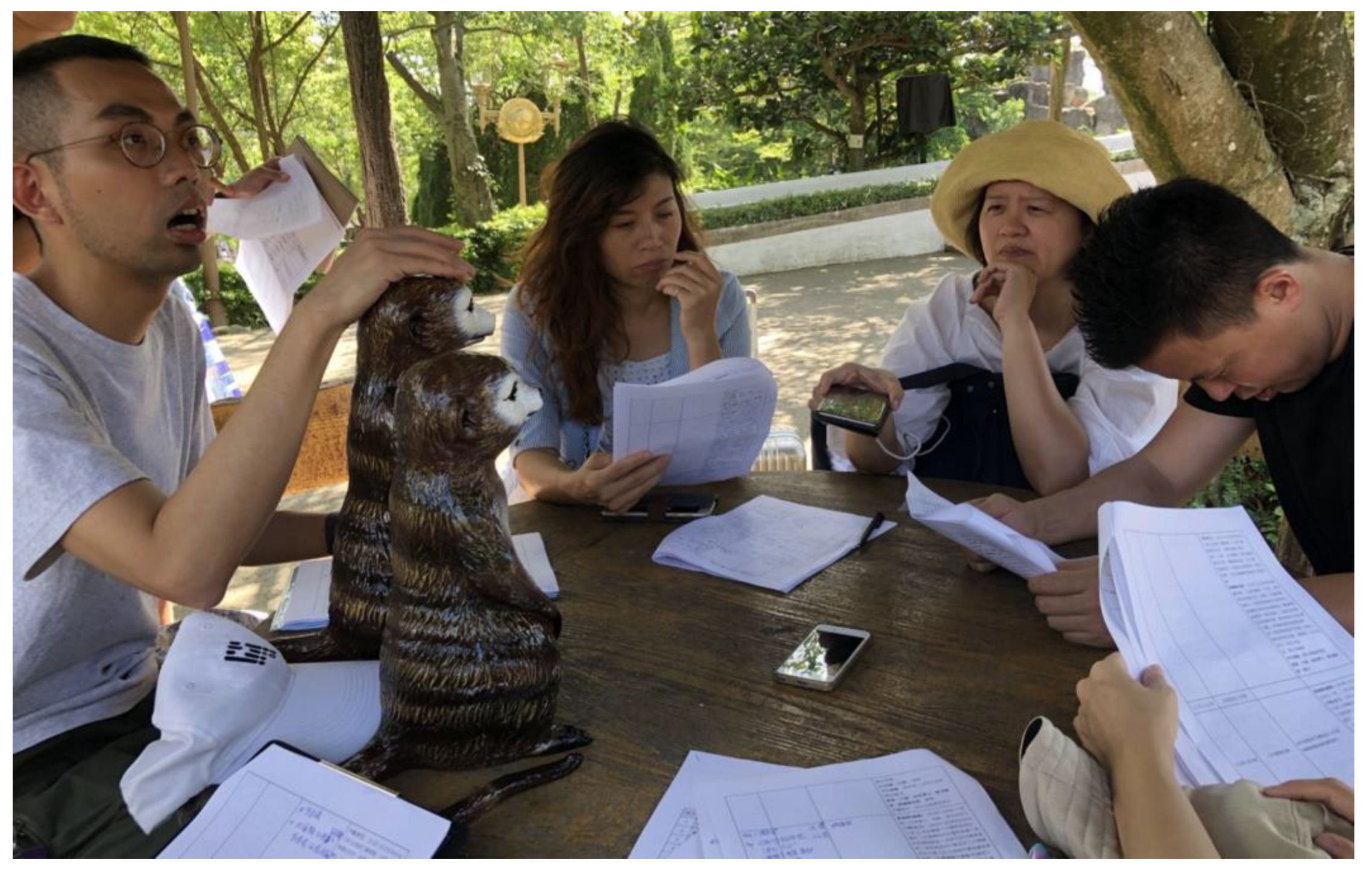
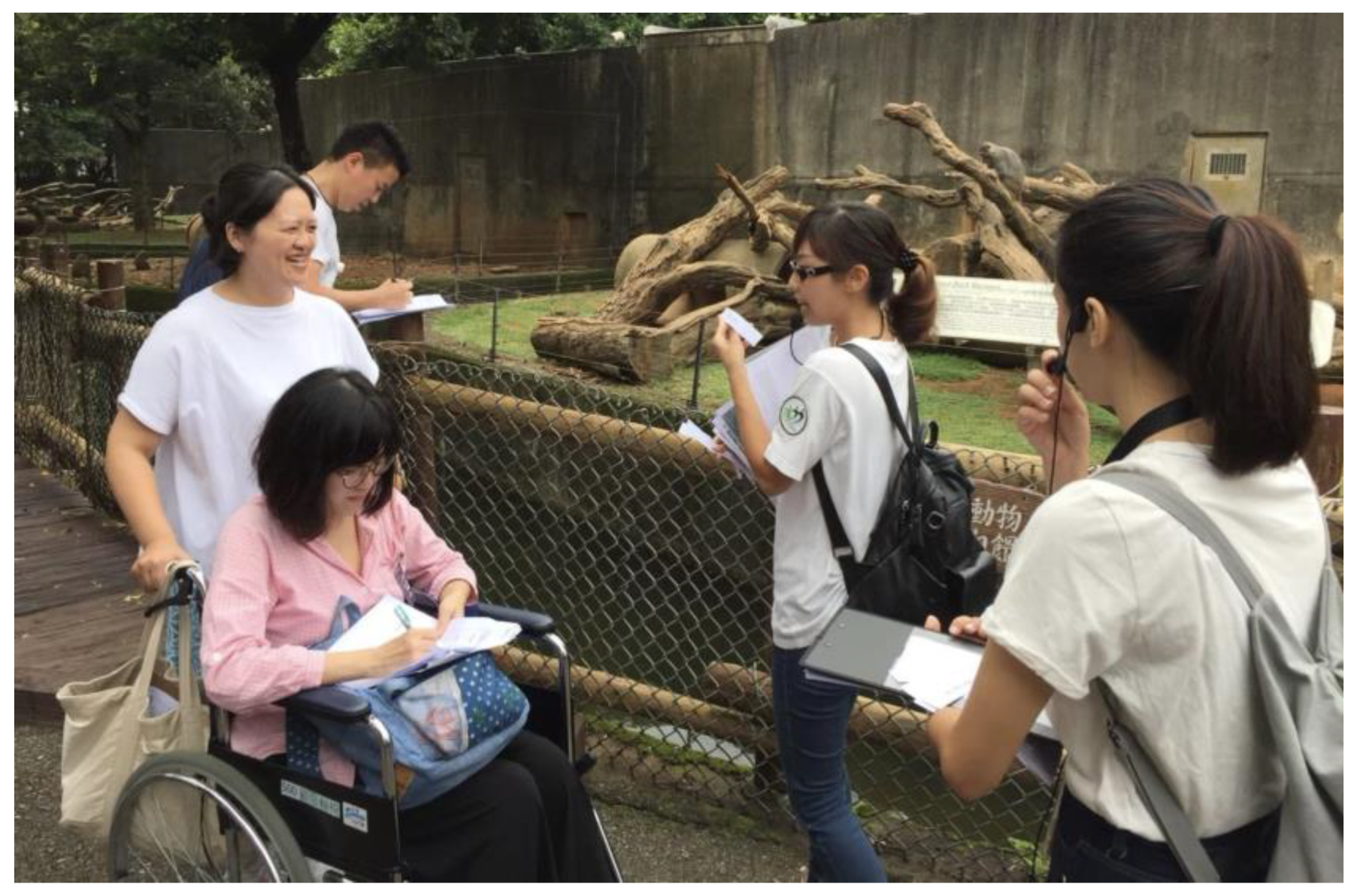
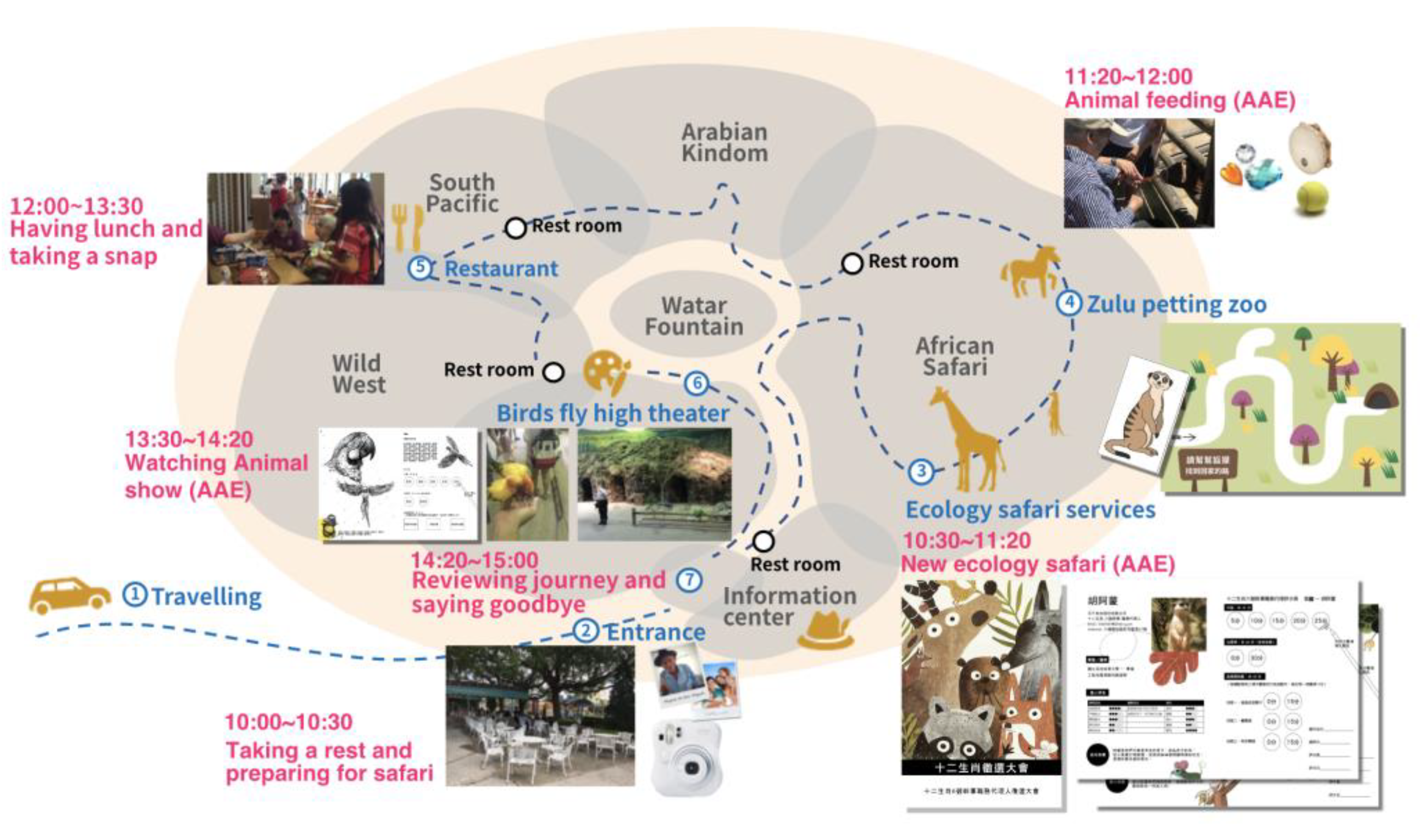
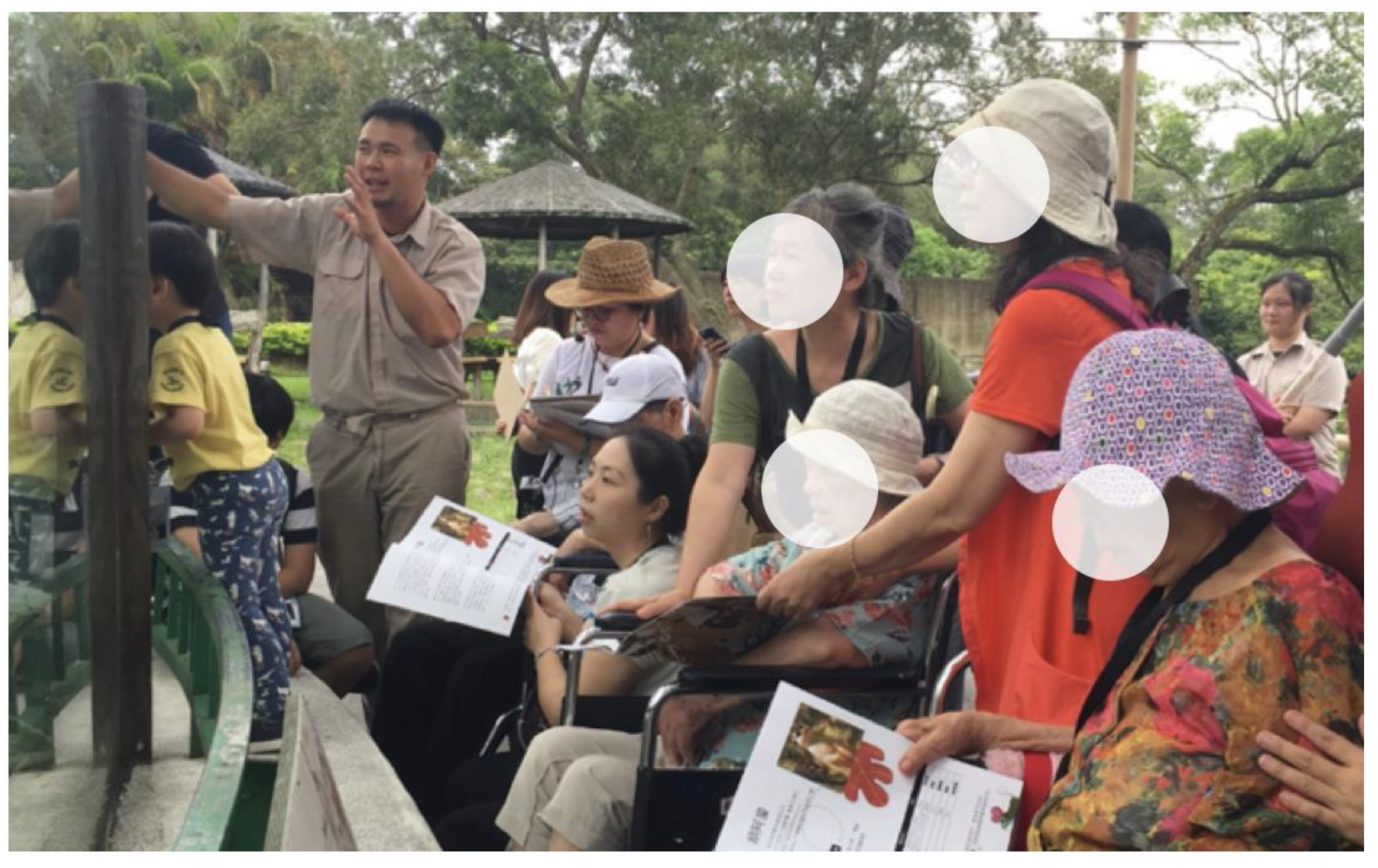
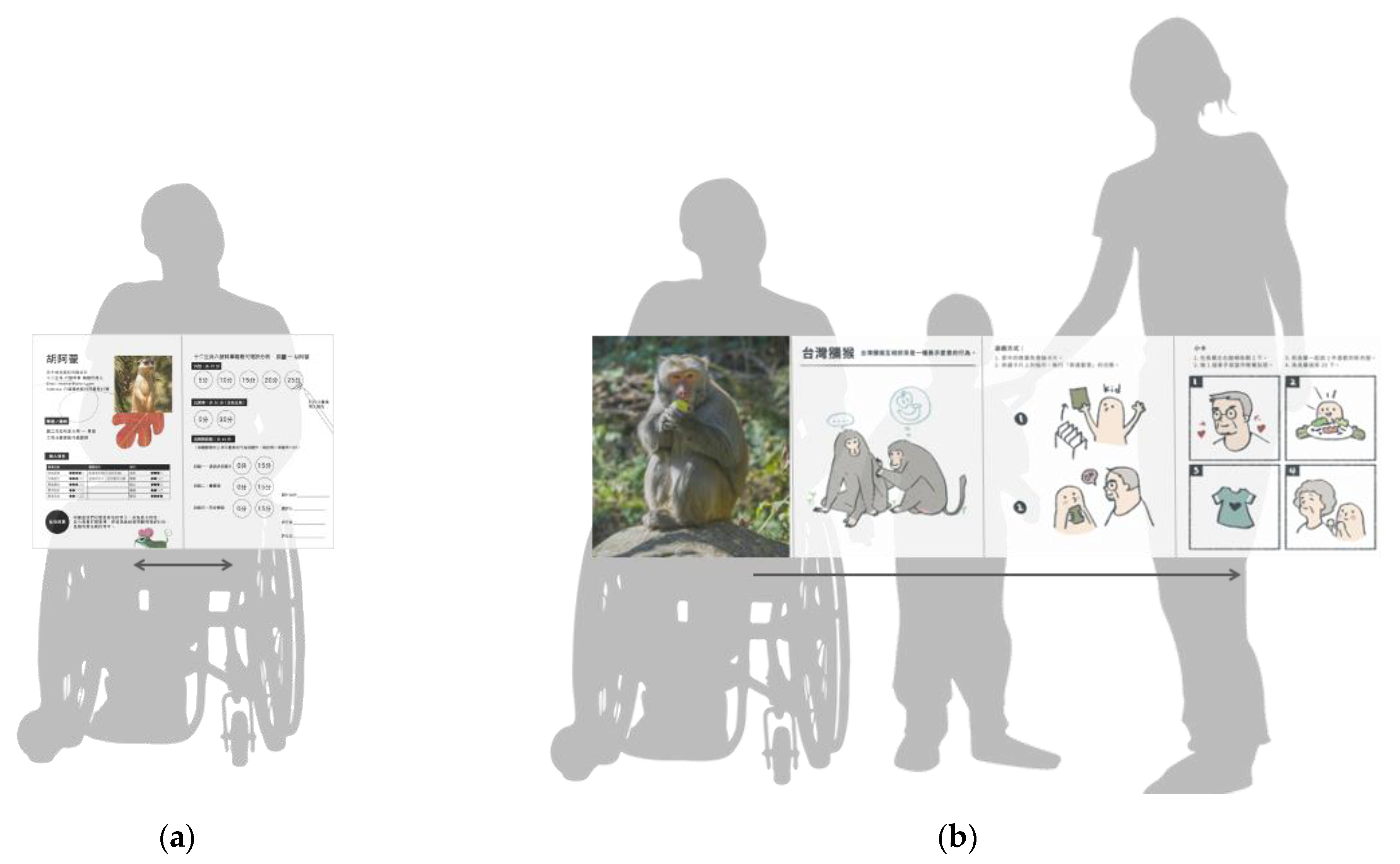
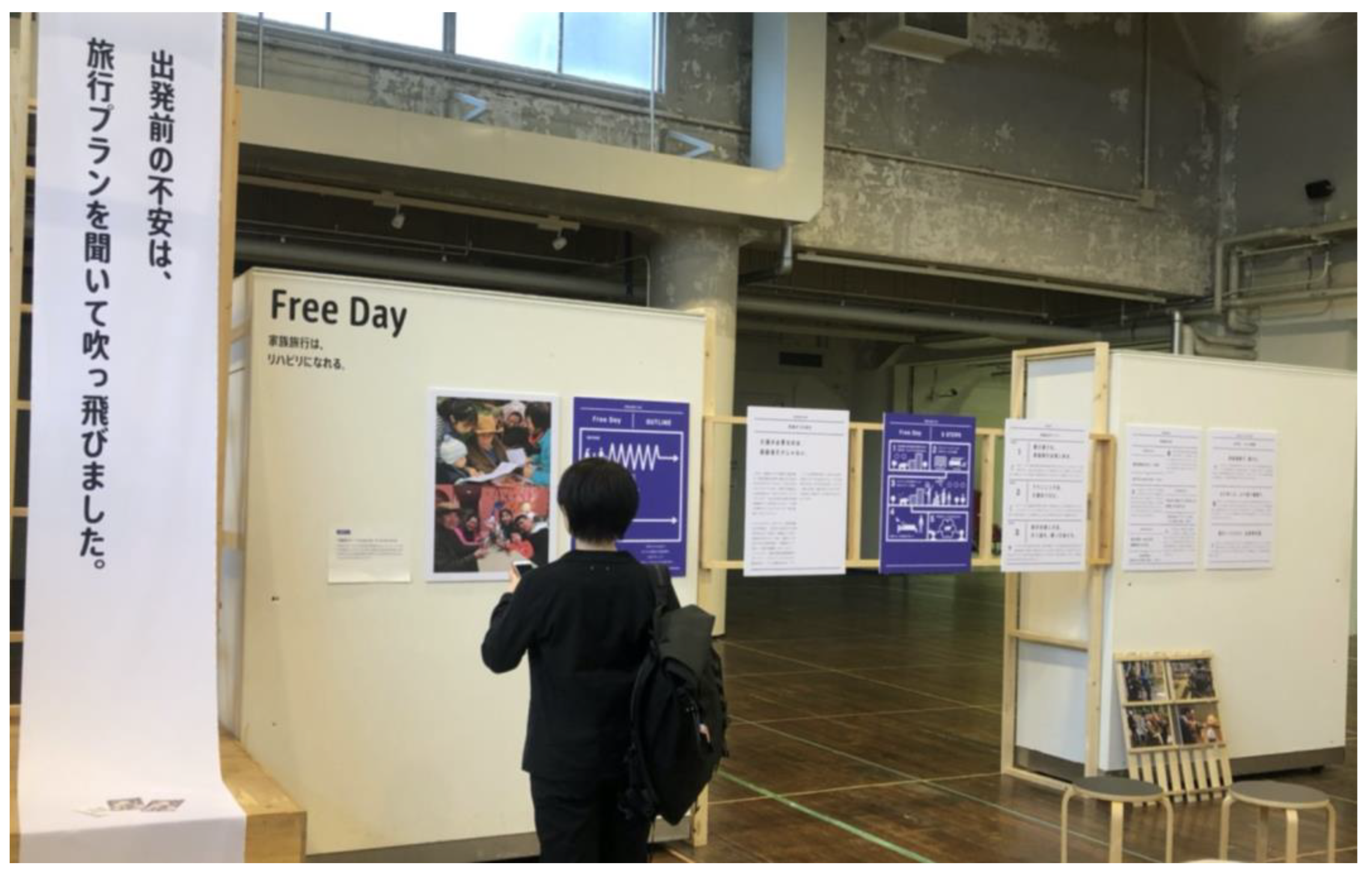

| Member | Background/Titles of Members in the Organization |
|---|---|
| A1 | Leofoo manager/CEO |
| A2 | Leofoo manager/Service design director |
| A3 | Leofoo manager/Program design director |
| A4 | Leofoo manager/Zookeeper |
| A5 | Dementia Experts/Caregiver of a homecare service company |
| A6 | Dementia Experts/Animal-assisted therapist of therapy organization |
| A7 | Dementia Experts/Art therapist of therapy company |
| A8 | Dementia Experts/Manager of a homecare service company |
| A9 | Government officer/Senior manager of Taiwan’s Ministry of the Interior |
| A10 | Designer/Design director of a social innovation platform company |
| Stage | Participants |
|---|---|
| Design for value proposition |
|
| Design for value-in-context |
|
| Design for value constellation |
|
| Values | Motivation | Evidence |
|---|---|---|
| Social justice Positive public image | Allowing PwD and carers to have freedom to enjoy travelling as other people | “Many elderly people have visited Leofoo Park when they were young, so I hope we can welcome our customer and gave them pleasure again” (A1) |
| Capable Creativity | Uncovering valuable resources of Leofoo Park to explore innovative ideas for PwD and cognitive training | “Some of the activities in ecology safari service of Leofoo Park are similar to cognitive trainings…We can take this as a new challenge to redesign these services to provide fun cognitive training” (A5) |
| Finding opportunities to link their core competences with DFVD | “I am looking forward to using our core assets to design new services for PwD… if it is possible, then we might be able to create a new business model” (A2) | |
| Partnership | Exploring opportunities to leverage resources of others to address PwD’s needs | “Since the experience of interacting with mild PwD is similar to the interaction with kids, I think the dementia experts can help up redesign our core services for PwD” (A3) |
| Feeling connected, open minded, willing to make contribution for PwD | “I am really appreciated that the Leofoo Park opened this opportunity to try something different…this project can be an example to promote our efforts on innovation” (A8) |
| Values | Motivation | Evidence |
|---|---|---|
| Empowered Independent Honor Elders | To allow PwD have active roles and unique experiences | “This journey seems fun to me, because I really hope to tell some interesting story about this animal to my grandson”—one of PwD “This journey gave my father an active role, so he will not just stand aside and watch us to play”—one of the family carer |
| Safety | To ensure a safe trip | “The design of the schedule and the suggested route are thoughtful. They have considered the needs of PwD.”—one of the family carer |
| Pleasure | To create memory of family interaction | “All the family members are looking forward to go travel with our mother”—one of the family carer |
| Healthy | To motivate PwD to go out for social interaction | “Travelling is a really great incentive for me to ask my father to out. Especially, when he finds that he can interact with his grandson, he becomes really excited”—one of the family carer |
| Equality | To find others starting to recognize and welcome family with PwD | “Finally, there is someone who knows our needs. I have been searching for suitable activities for our family since my mother suffered from dementia”– one of the family carer |
| Values | Motivation | Evidence |
|---|---|---|
| Social Justice Equality Democracy Honor elders | To facilitate people to change the impression of living with PwD | “I have learned that it is possible to enjoy the life of living with my father…I really hope to support this kind of service and to change people’s impression of living with PwD”- a family carer “This is a great story for our magazine… the idea to welcom everyone to enjoy healthy life is same with our magazine, and we would like to promote on our issues “- the senior manager of a healthy magazine company |
| Influential | To trigger industries to engage into social challenges | “FreeDay has demonstrated the potential that the integration of tourism and long-term care can not only lead to the improvement of their services and business model, but also the well-being of the society”- the government officer |
| Achievement Ambitious | To improve the acceptance and the quality of the existing service | “travelling with family is an activity worth integrating into a care plan, since it helps me encourage PwD to stay active.”- an occupational therapist“FreeDay has inspired me to find new ways other than accessibility facilities to improve our services for disables or PwD”- the manager of a visitor destination |
| Stage | Design for Value Proposition | Design for Value-In-Context | Design for Value Constellation |
|---|---|---|---|
| Emergence of values |
|
|
|
| Development of values |
|
|
|
| Grounding of values |
|
|
|
| Stage | Challenge | Tools/Activities | Effects |
|---|---|---|---|
| Design for value proposition |
| Service Safari | To find potential opportunities to leverage others’ core competences for DFVD development |
| Service Staging | To enable reflection, controversial issues, and re-alignment through values rendering | ||
| Desktop Walkthrough | To ground the values of DFVD from both holistic and detailed views | ||
| Design for value-in-context |
| Storytelling | To motivate PwD and carers with meanings |
| Contextual Interview |
| ||
| Service Blueprint | To facilitate Leofoo Park to evaluate the values from different aspects and make strategy for adoption | ||
| Design for value constellation |
| Design Initiatives | To create more dialogs and connections through emerging values |
| Expectation Map | To align the new stakeholders and build up their connection | ||
| Service Prototype | To validate and stabilize the network to drive diffusion |
Publisher’s Note: MDPI stays neutral with regard to jurisdictional claims in published maps and institutional affiliations. |
© 2021 by the authors. Licensee MDPI, Basel, Switzerland. This article is an open access article distributed under the terms and conditions of the Creative Commons Attribution (CC BY) license (https://creativecommons.org/licenses/by/4.0/).
Share and Cite
Wu, C.-S.; Sung, T.-J. Applying Values-Led Communication Design to Engage Stakeholders in Developing Dementia-Friendly Visitor Destinations. Sustainability 2021, 13, 4504. https://doi.org/10.3390/su13084504
Wu C-S, Sung T-J. Applying Values-Led Communication Design to Engage Stakeholders in Developing Dementia-Friendly Visitor Destinations. Sustainability. 2021; 13(8):4504. https://doi.org/10.3390/su13084504
Chicago/Turabian StyleWu, Chih-Shiang (Mike), and Tung-Jung (David) Sung. 2021. "Applying Values-Led Communication Design to Engage Stakeholders in Developing Dementia-Friendly Visitor Destinations" Sustainability 13, no. 8: 4504. https://doi.org/10.3390/su13084504
APA StyleWu, C.-S., & Sung, T.-J. (2021). Applying Values-Led Communication Design to Engage Stakeholders in Developing Dementia-Friendly Visitor Destinations. Sustainability, 13(8), 4504. https://doi.org/10.3390/su13084504






